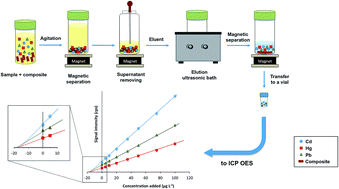A modified ZSM-5 zeolite/Fe2O3 composite as a sorbent for magnetic dispersive solid-phase microextraction of cadmium, mercury and lead from urine samples prior to inductively coupled plasma optical emission spectrometry†
Abstract
The purpose of this work is to present a simple, fast, cost effective and environmentally friendly magnetic dispersive solid-phase microextraction (MDSPME) method, employing a composite based on ZSM-5 zeolite decorated with iron oxide magnetic nanoparticles (i.e., ZSM-5/Fe2O3) as a valuable sorbent, for the simultaneous separation and preconcentration of cadmium (Cd), mercury (Hg) and lead (Pb) from urine samples for subsequent measurement by inductively coupled plasma optical emission spectrometry. The composite was first saturated with zinc and then modified with a hexadecyltrimethylammonium bromide surfactant and sodium diethyldithiocarbamate trihydrate chelating agent. A two-step multivariate strategy, using Plackett–Burman and circumscribed central composite designs, has been employed to optimize experimental parameters affecting MDSPME. The method has been evaluated under optimized extraction conditions (i.e., amount of sorbent, 50 mg; sample pH, 4.0; extraction time, 3 min; eluent solvent, nitric acid; eluent solvent volume, 432 μL; eluent solvent concentration, 11.8 M and elution time, 2 min) using standard addition calibration. Calibration curves using standards between 0 and 100 μg L−1 gave a good linearity with correlation coefficient values ranging from 0.998 to 0.9997 for Cd, from 0.998 to 0.9998 for Hg and from 0.9996 to 0.9999 for Pb (N = 8). The repeatability of the method has been evaluated at 3 and 50 μg L−1 obtaining coefficients of variation between 2 and 5% (n = 6). The limit of detection values ranged from 0.15 to 0.20 μg L−1 for Cd, from 0.42 to 0.73 μg L−1 for Hg and from 0.23 to 0.39 μg L−1 for Pb. These values satisfy the threshold limit (3.4 μg L−1 for Cd, 10.0 μg L−1 for Hg and 85.0 μg L−1 for Pb) established by the Ministry of Labour and Social Affairs (Spain) for normal content of these metals in human urine and by the World Health Organization for normal mercury content in urine (i.e., 10 μg L−1). Finally, three urine samples were used to assess the applicability of the developed procedure. Recovery values ranged between 87 and 107% showing negligible matrix effects.



 Please wait while we load your content...
Please wait while we load your content...